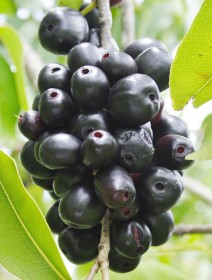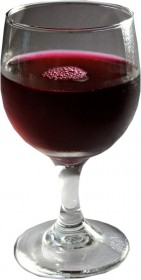According to Hindu tradition, Rama subsisted on the Jamun fruit in the forest for 14 years during his exile from Ayodhya. Because of this, many Hindus regard this as the ‘fruit of the Gods’ especially in Gujarat, India

I had not eaten Jamun in over a decade, until last week. And, it took my friend Sonia who is visiting from overseas, to point me to a Jamun tree here in Barbados where I could have Jamun to my heart’s content. Located on a stretch of road behind the Pine housing area and where parking is almost non-existent, I pulled off the road and together we walked over to the Jamun tree.

The tree was laden with its ripe, purple clumps of shiny jewels, all we had to do was reach out our hands and pick them. For a while, I just stood under the tree, shaded from the hot sun, enveloped by its branches, full of bright green leaves and heavy with fruit, almost touching the ground. It was so quiet, so peaceful. I put the first Jamun into my mouth, pressed the fruit with my tongue to the roof of my mouth and felt the fruit pop as the sweet, tart juice filled my mouth. I popped another Jamun into my mouth and then another, and another… I ran back to the car in glee, got a plastic bag and then started picking Jamun like a crazed person. My friend Sonia had gone off several yards away to sit and enjoy the scenery.
A few minutes into my picking, a girl, aged 13 or 14, still in her school uniform, joined me under the tree. I saw her approach from one of the nearby houses. We greeted each other and exchanged names. Her name was Sherice. Sherice said she came out because she saw my friend and I picking the fruit and she wanted to know more about it; she had questions – is the fruit edible? Is it good for you? How can I use the fruit?

Jamun trees are evergreen trees, in other words, they can live for more than 100 years. The fruit when ripe looks like grapes. The skin is purple, almost black and shiny. They can be eaten as is, or, a favourite way to eat them is slightly bruised with some salt. They are sweet and tart and so the salt helps to cut some of the tartness. But try one now and taste it. Sherice shook her head and smiled. I popped a Jamun into my mouth, “see,” I said, “go ahead. Try it.” Sherice hesitantly placed a Jamun into her mouth and then bit down on it. Smiling, she said, “Oh, that’s not bad!”
No, it’s not bad at all. Actually, Jamun is a fruit that it good for your health and not just for enjoyment. It is a very good source of Vitamin C and the skin has antioxidant properties. Antioxidants help fight certain diseases and protect our bodies. Actually, societies that practice herbal medicine (alternative medicine, traditional medicine) use the leaves and the seeds of the Jamun fruit to control some illnesses – for example, diabetes, digestive problems and high blood pressure. See how good Jamun is for you?
“Can I make drink with it?” Sherice asked. Jamun can be juiced and be used as a drink. The pulp can be used to make jams and tarts too. I know that it can be made into wine also but you’re too young for that! Some people make vinegar with it as well. “So how do I make the drink?” You squish it (with clean hands), add some hot water, leave it overnight and strain it off in the morning and squeeze the pulp to get out all of the juice. Sweeten it and chill it in the fridge. Sherice turned, pulled a plastic bag out of a pocket in her school uniform and set about busily picking Jamun.
I felt so happy. I was happy because Sherice was interested in learning, I was happy because Sherice was so receptive, I was happy because I hoped I had imparted some knowledge that she will pass on to others.
Too often in the Caribbean I encounter teenagers and adults that declare their dislike for local fruits or lack of awareness of the existence of local fruits apart from bananas. They pass up the local bounty for the imported apples, grapes, pears, plums, peaches, nectarines etc. I am not saying that you should not buy and enjoy those fruits but I’d like you to enjoy the fruits grown in your own backyard with the same exuberance.
Please let’s not take what we have for granted. And don’t let’s wait until someone from outside say that something is good before we pay attention. Right now the world cannot get enough pomegranate juice because successful tests have shown that it assists in reducing heart disease risk factors among other things.
Join me in my crusade to encourage the eating of more local fruits and foods in general, not just because they are local and cheaper but more importantly, because they are good for you – from guavas, to passion fruit, to soursop to five-finger to…. If you don’t want to eat the fruit itself with all it’s excellent dietary fibre, then juice it. You know that I like Coco Cola as much as the next person but we have to strive to bring a balance to our consumption.
SHUBH DIWALI!
Cynthia
tasteslikehome@gmail.com
www.tasteslikehome.org
Jamun Juice
Ingredients
Equal parts jamun and water (6 cups Jamun, 6 cups water)
1 teaspoon whole all spice berries
1 (3-inch) piece cinnamon stick
3 whole cloves
Method
Wash jamun, drain and add to a large bowl
With clean hands or gloved with latex gloves, squish the jamun
Add water and spices to a pot and bring to a boil. Let boil for 2 minutes
Pour boiled water and spices into the bowl with mashed jamun, stir, and cover and let steep overnight
Strain juice after overnight steeping; using clean hands, squeeze excess juice from pulp
Pour juice into bottle and refrigerate (optional – sweeten to taste)

